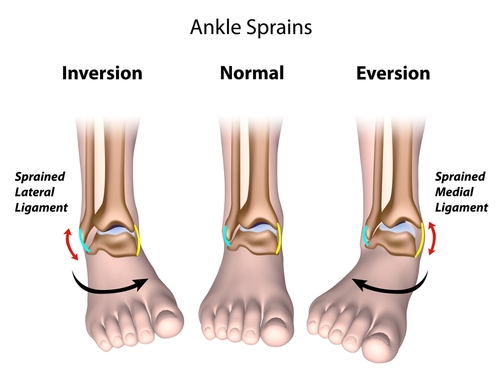Ankle Sprain/Strain
Ankle sprains cause symptoms like pain and swelling, and without treatment, they can result in permanent disability, painful arthritis, and other serious issues. As top-rated chiropractic and sports injury specialists providing state-of-the-art care for both adult and pediatric patients in Herndon and Sterling, Virginia, Recharge uses advanced technology to diagnose ankle sprains, providing patient-centered care options for faster relief of symptoms and speedier healing.
How is the ankle designed, and what is the ankle's function?
The ankle is a "hinged" joint capable of moving the foot in two primary directions: away from the body (plantar flexion) and toward the body (dorsiflexion). It is formed by the meeting of three bones. The end of the shinbone of the leg (tibia) and a small bone in the leg (fibula) meet a large bone in the foot, called the talus, to form the ankle. The end of the shinbone (tibia) forms the inner portion of the ankle, while the end of the fibula forms the outer portion of the ankle. The hard, bony knobs on each side of the ankle are called the malleoli. These provide stability to the ankle joints, which function as weight-bearing joints for the body during standing and walking.
Ligaments on each side of the ankle also provide stability by tightly strapping the outside of the ankle (lateral malleolus) with the lateral collateral ligaments and the inner portion of the ankle (medial malleolus) with the medial collateral ligaments. The ankle joint is surrounded by a fibrous joint capsule. Tendons that attach the large muscles of the leg to the foot wrap around the ankle both from the front and behind. The large tendon (Achilles tendon) of the calf muscle passes behind the ankle and attaches at the back of the heel. A large tendon of the leg muscle (posterior tibial tendon) passes behind the medial malleolus. The peroneal tendon passes behind the lateral malleolus to attach into the foot.
The normal ankle has the ability to move the foot, from the neutral right-angle position to approximately 45 degrees of plantar flexion and to approximately 20 degrees of dorsiflexion. The powerful muscles that move the ankle are located in the front and back portions of the leg. These muscles contract and relax during walking
The ankle is a hinged joint
Ankle pain can be caused by injury or disease of the ankle joint
The severity of ankle sprains can range from mild (which can resolve within 24 hours) to severe (which can require surgical repair).
Tendinitis of the ankle can be caused by trauma or inflammatory arthritis
What injuries can cause ankle pain?
Ankle sprains are one of the most common musculoskeletal injuries. Sprains are injuries to the ligaments of the ankle, causing them to partially or completely tear as a result of sudden stretching. They can occur on either or both of the inner and outer portions of the ankle joint. Ankle sprains more commonly happen when there is a preexisting muscle weakness in the ankle area or a history of previous ankle injuries. The typical injury occurs when the ankle is suddenly "twisted" in a sports activity or by stepping off an uneven surface. The pain is initially severe and can be associated with a "popping" sensation. Immediate swelling over the area of injury often occurs as the injured blood vessels leak fluid into the local tissue. Examination of the area may cause severe pain when the ankle is moved. The degree of pain may not necessarily indicate the degree of damage to the ligament(s). Ligament injuries are often graded from I to III, ranging from partial to complete tears. Partial tears retain some ankle stability, whereas complete tears lose stability because the strapping ligaments no longer brace the ankle joint. After an examination, significant ankle sprains are commonly evaluated with an X-ray. X-rays can determine whether there is an accompanying break (fracture) of the bone.
Acute ankle sprains are initially treated with ice, rest, and limiting the amount of walking and weight-bearing on the injured ankle. The leg can be elevated to reduce swelling, and crutches are often recommended to avoid further trauma to the injured ligaments. Anti-inflammatory medications can be given to reduce local inflammation. Ice packs help decrease further swelling of the area and can reduce pain. Patients with severe injuries are placed in immobilization casts. Surgical repair of grade III injuries is considered, especially for those patients contemplating future athletic participation. Physical therapy programs are part of the rehabilitation process, incorporating strengthening exercises of the lower leg muscles. Broken ankles (fractures) can accompany ankle sprains or occur without sprains. Fractures are repaired with casting to immobilize the bone for healing. Depending on the severity, fractures can require orthopedic casting, surgical procedures including pinning, and open repair of the fractured bone.
What conditions can cause ankle pain?
Inflammatory types of arthritis (inflammation of the joint) that can involve the ankle area include rheumatoid arthritis, reactive arthritis, gouty arthritis, and psoriatic arthritis, among others. They generally are not induced by trauma injury and often develop gradually. A thorough evaluation by a doctor with blood testing can be necessary for ultimate diagnosis. These types of arthritis are associated with pain, swelling, stiffness, redness, and warmth in the involved area. These diseases each have unique management as described elsewhere.
Other conditions of the ankle which can cause ankle pain include tarsal tunnel syndrome. This is a result of nerve compression at the ankle as the nerve passes under the normal supportive band surrounding the ankle called the flexor retinaculum. Tarsal tunnel syndrome is described elsewhere.
Contact Our Chiropractic Center Today
Are you ready to alleviate your Ankle Sprain today? Call Recharge Sports Injury Center at (703) 481-4400 for an appointment with our chiropractors!




